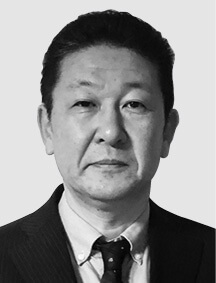Innovation for Next-generation Energy[ⅱ]Distributed Power Supply SolutionsSystem Integration Solution for Self-consumption PV Generation and EVs with Onboard Fast Chargers
Highlight
Japan is seeking to increase the share of renewable energy in its power supply market, creating expectations that renewables will provide a way to combine self-consumption photovoltaics with electric vehicles that produce zero emissions on the road. Increasing the availability of electric vehicle chargers will be a key requirement for attaining this objective. Conventional electric vehicle chargers are stationary units with an availability of about one charger for every 10 electric vehicles at present. But in addition to these stationary chargers, electric vehicles can be given a fast charging function by adding a high-frequency transformer and using the drive inverters to rapidly charge the battery. This article proposes an electric vehicle configuration that features an onboard fast charging function and enables easy connection to a direct current power generation source such as photovoltaics. This configuration should help reduce carbon emissions while bringing more value to suburban and rural users than urban users.
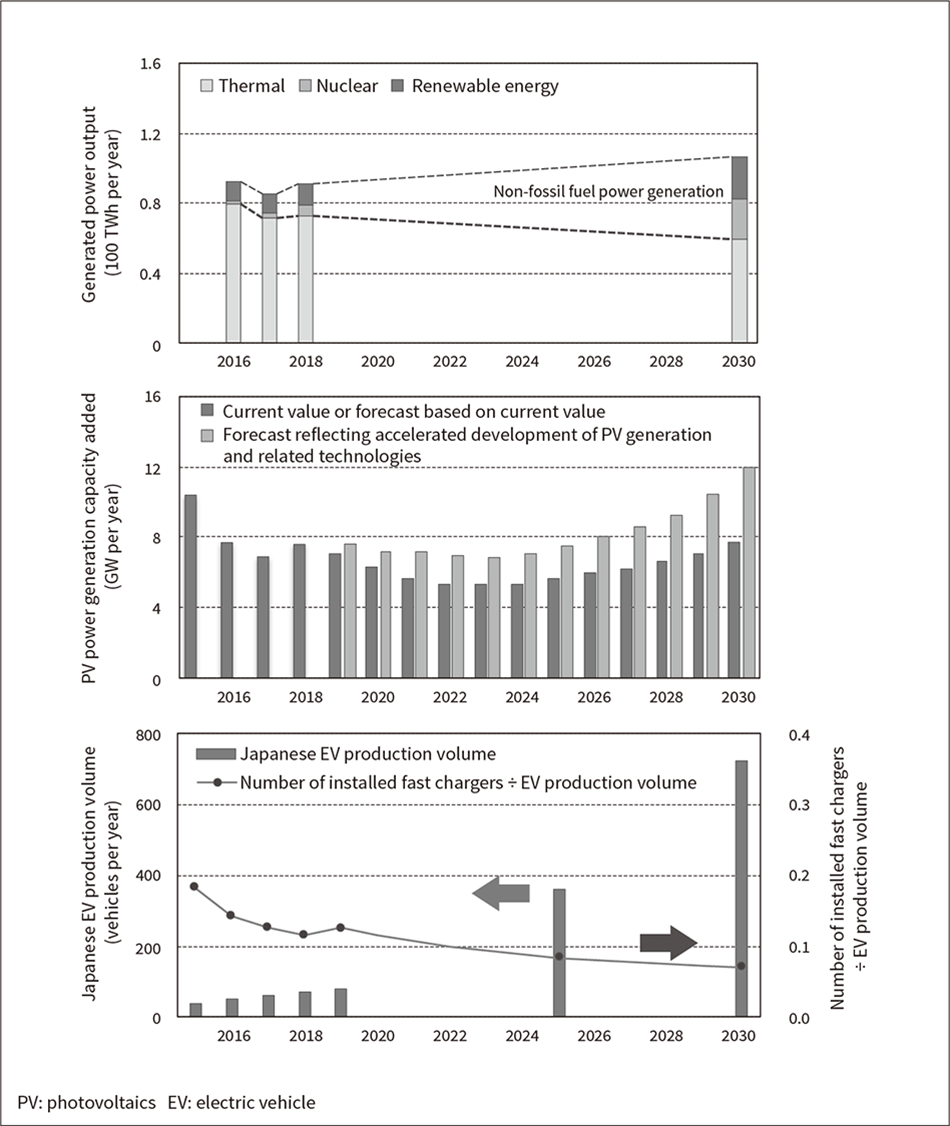
1. Introduction
The introduction of a feed-in tariff (FIT) system in Japan has made photovoltaics (PV) a popular way to profit by selling generated power back to power companies. Advances in FIT-based PV power generation technology have also lowered the cost of this type of power generation. As it becomes more popular and widespread, self-consumption PV power generation will increasingly replace conventionally generated power in the future, and should provide benefits as a power source that is free of the emissions that cause global warming while enabling power self-sufficiency in times of crisis. At the same time, electric vehicles (EVs) are becoming increasingly common in the transportation sector worldwide. Japan’s Ministry of Economy, Trade and Industry (METI) is planning for a reduction of CO2 emissions, and has created an EV use forecast that anticipates the share of EVs growing to about 50 to 70% of all vehicles in Japan in just under 30 years. Mileage, battery cost, charge time, charge power, and spent battery recycling are major challenges in the rise of EVs and other types of electrically powered vehicles(1). The ability to use PV or other renewable energy sources for low-loss transmission of generated power to charge EVs, and providing equipment to increase charging availability will likely be the particularly crucial challenges.
Based on these challenges, this article presents a system integration concept designed to efficiently transmit generated power to the rising numbers of EVs in the future with minimal loss of charging availability. The system integration concept’s features the ability to connect stationary direct current (DC) PV power generation equipment to EVs that have been provided with a charge function that uses the vehicle’s drive inverters for fast charging.
2. Connecting Self-consumption PV Generation to Fast-charging EVs and the Challenges
Figure 1 shows the growth trends of the power, PV, and EV markets in Japan. Japan is expected to continue relying on fossil fuels for power generation for several more years, followed by steady growth of PV as a source of non-fossil fuel power generation. Assuming a reasonable amount of power consumption, self-consumption PV will likely be installed by consumers and other users to satisfy the site requirements of a relatively large installation area per unit output and few structures blocking sunlight. The power usage trend is marked by an EV production volume that is expected to increase, but the number of fast chargers installed is not expected to rise as quickly. This trend is creating a concern that the number of fast chargers installed will not increase without growth in the absolute number of EVs in suburban and rural areas where it is easier to satisfy the PV power generator site requirements.
Figure 2 illustrates the method used to connect self-consumption PV generation to a fast EV charger. Figure 2 (a) shows how an EV is charged from PV power generator over existing alternating current (AC) lines. The DC PV output charges a mobile EV over an AC line through a stationary EV charger composed of a transformer, AC/DC converter, and DC/DC converter, and is connected on an AC line to a DC/DC converter, AC/DC converter, and transformer. Since this method charges through multiple converters and transformers, transmitting the power generated by the PV equipment to the EV results in a corresponding power loss. The transformer in the EV charger also generates a standby loss even when the EV is not being charged. Figure 2 (b) shows a method that connects a DC/DC converter to PV and enables an EV provided with a DC/DC converter-based fast charging function to be charged directly over a DC line(2). With this method, the stationary equipment used to charge the EV can be composed of a DC line and connector. The transformer in the EV charger also generates no standby loss. This method could therefore enable easy DC line connection of multiple EVs provided with a fast charging function, but the challenge will be mounting onboard DC/DC converters for rapidly charging the EVs.
Fig. 1—Growth Trends of Japan’s Power, PV, and EV Markets Japan’s reliance on fossil fuels for power generation is expected to continue for several years, followed by sustained growth of photovoltaic power generation. The power consumption trend is marked by an increasing EV production volume, but the number of installed fast chargers is not expected to keep pace with the EV production volume growth.
Japan’s reliance on fossil fuels for power generation is expected to continue for several years, followed by sustained growth of photovoltaic power generation. The power consumption trend is marked by an increasing EV production volume, but the number of installed fast chargers is not expected to keep pace with the EV production volume growth.
Fig. 2—Methods of Connecting Self-consumption PV Generation and EV Fast Charger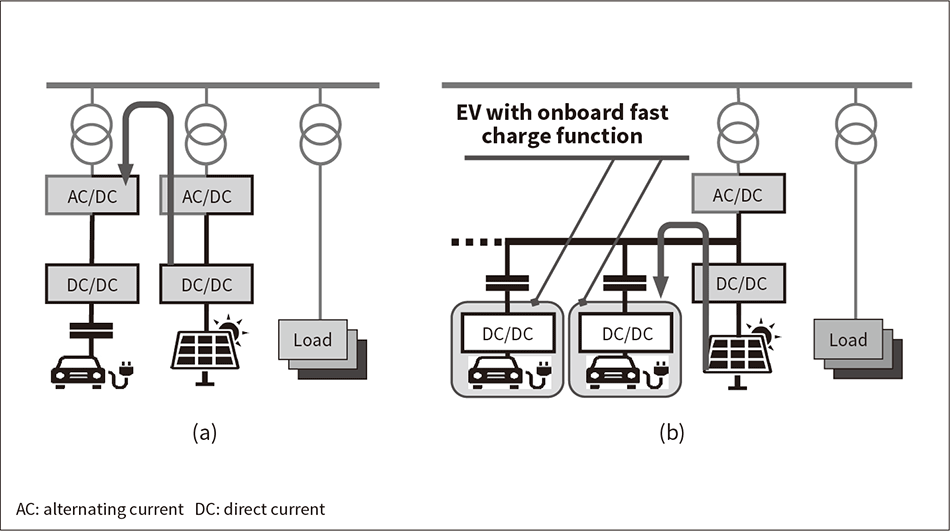 Figure 2 (a) shows a method by which power is transferred through multiple transformers and converters when an EV is charged from a PV power generator over an AC power distribution line, and the mobile EV is connected to and charged from a ground-based EV charger. The transformer in the EV generates standby loss even when the EV is not being charged. In the method of Figure 2 (b), a DC/DC converter is connected to the PV, and an EV with an onboard fast charging function is charged by a DC/DC converter over a DC line, enabling the ground-based EV charger to be composed of only the DC line and a connector. Multiple EVs provided with a fast charging function can easily be connected to the DC line.
Figure 2 (a) shows a method by which power is transferred through multiple transformers and converters when an EV is charged from a PV power generator over an AC power distribution line, and the mobile EV is connected to and charged from a ground-based EV charger. The transformer in the EV generates standby loss even when the EV is not being charged. In the method of Figure 2 (b), a DC/DC converter is connected to the PV, and an EV with an onboard fast charging function is charged by a DC/DC converter over a DC line, enabling the ground-based EV charger to be composed of only the DC line and a connector. Multiple EVs provided with a fast charging function can easily be connected to the DC line.
3. Proposed EV with Onboard Fast-charge Function
Fig. 3—Circuit Configuration of DC PV Power Generator and Connected EV that Uses Drive Inverters for Fast Charging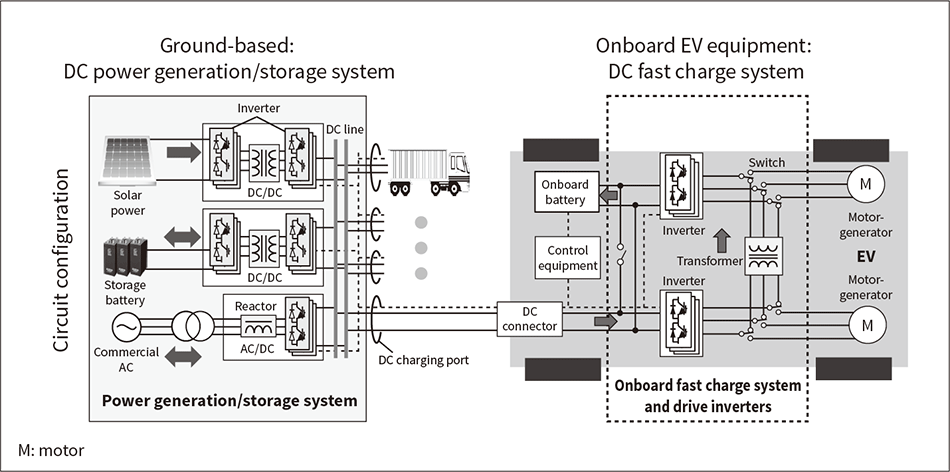 Inverters and motor-generators are provided for drive power on the EV’s two drive shafts. A transformer and switch have also been added, enabling use of the drive inverters for fast charging.
Inverters and motor-generators are provided for drive power on the EV’s two drive shafts. A transformer and switch have also been added, enabling use of the drive inverters for fast charging.
Fig. 4—Simplified Operation and Power Flow of EV Using Drive Inverters for Fast Charging Mode 1 is the mode in which the ground-based DC/DC converter for charge control is connected, enabling support for conventional charger infrastructure. Mode 2 configures an onboard fast charger when there is no ground-based DC/DC converter for charge control. Mode 3 is the inverter-driven EV driving mode.
Mode 1 is the mode in which the ground-based DC/DC converter for charge control is connected, enabling support for conventional charger infrastructure. Mode 2 configures an onboard fast charger when there is no ground-based DC/DC converter for charge control. Mode 3 is the inverter-driven EV driving mode.
To address the challenges discussed in the previous section, Figure 3 shows the specific EV onboard equipment configuration needed to use the method in Figure 2 (b). A transformer used to connect to the commercial AC grid, and an AC/DC converter are installed and connected to a DC line in the ground equipment. PVs and a battery are also connected to the DC line, each through a DC/DC converter. The battery is installed to buffer variations in the PV power generation output. The DC line is connected directly to the mobile EV through a connector, without passing through the stationary DC/DC converter. The equipment in the EV consists of the same control equipment, onboard battery, vehicle drive inverters, and motor-generators found in conventional EVs, along with a transformer used for fast charging and a switch used to select vehicle driving or the fast charging function. The area enclosed by broken lines in Figure 3 indicates the static power generation system that serves as both the onboard fast charging system and the drive inverters, excluding the motor-generators. The figure shows a motor-generator mounted on each of the right and left drive wheels, but configurations that distribute the drive power to the front and back wheels or provide drive power to one shaft from a single unit are also possible.
This onboard system is expected to generally operate in three modes (see Figure 4). In mode 1, the inverters are shut down, a DC/DC converter (not shown) is placed on the stationary side of the connector, the onboard battery is connected directly to the connector, and charging is controlled by the stationary DC/DC converter. This mode enables connection to an existing EV charger. In Mode 2, a high-frequency transformer is connected between the two vehicle drive inverters and then connected to the onboard battery. The vehicle motor-generators are disconnected to enable onboard fast charging. This mode provides high-frequency drive on the AC side of the inverters and runs a cooling system to enable fast charging within the allowable temperature rise range. It can also use the electricity losses from the inverters and transformer as an onboard heat source while charging in cold weather. Mode 3 is the EV driving mode in which the high-frequency transformer is disconnected and the vehicle drive inverters are connected to the vehicle motor-generators.
4. Value of Proposed System from Standpoint of Energy Use
This article has proposed a system integration concept for connecting PV to an EV with an onboard fast charging function. This section describes the value of the concept from the standpoint of energy use.
4.1 Contribution to Cost Reduction and Low Carbon Emissions
Table 1 shows example estimates of the value contributed by the system in terms of cost reduction and low carbon emissions of mobile equipment. Estimate results will vary according to factors such as the unit prices of electric power and fuel, and the cost and efficiency of installing PV and other electrical systems. Initial vehicle costs and maintenance costs have also been excluded. The estimates shown were created for a user owning 12 commercial vehicles or vans that are driven 150 km per day.
Column (1) in the table is for internal combustion engine vehicles. Column (2) is for EVs charged by existing fast chargers connected to an AC distribution line. Column (3) is for EVs charged by connecting nearby self-consumption PV to existing fast chargers over an AC distribution line. Column (4) is for EVs with onboard fast charging function that are charged directly by connecting the self-consumption PV generator shown in Figure 3 to a DC line.
The vehicles in column (2) have zero emissions on the road. The vehicles in column (3) and column (4) have zero emissions both on the road and when charging. While the estimate figures will vary according to the preconditions as mentioned, connecting self-consumption PV power generators and EVs provide value in terms of contributing to the electric power costs for driving vehicles and to low carbon emissions. Since the vehicles in column (4) each have a fast charging function, they also have more opportunities to be charged from self-consumption PV power generators.
Table 1—Example Estimates of Cost Reduction and Low Emissions Compared to Internal Combustion Vehicles and Conventional EVs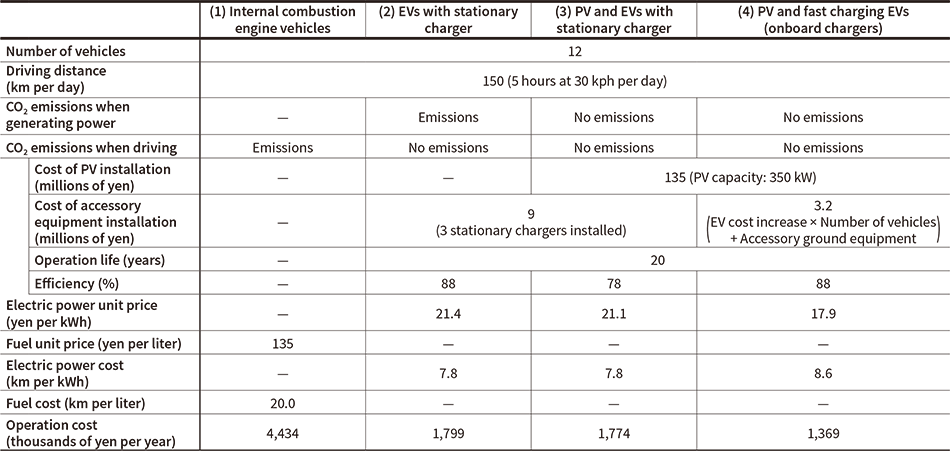 This table shows example estimates of fuel and electric power costs for driving and low carbon emissions for vans and other 1,500-cc-class commercial vehicles. Column (1) is for internal combustion engine vehicles. Column (2) is for EVs charged by stationary chargers connected to an AC distribution line. Column (3) is for EVs charged by a PV generator and stationary charger connected to an AC distribution line. Column (4) is for EVs that use a PV generator and the drive inverters for fast charging. The estimates shown here assume that the power generated by PVs is completely consumed by EV charging and supply to the power consumer’s equipment. The electric power costs shown in column (4) assume a 10% electric power cost improvement by using converter-generated heat for heating the vehicle interior when charging in winter.
This table shows example estimates of fuel and electric power costs for driving and low carbon emissions for vans and other 1,500-cc-class commercial vehicles. Column (1) is for internal combustion engine vehicles. Column (2) is for EVs charged by stationary chargers connected to an AC distribution line. Column (3) is for EVs charged by a PV generator and stationary charger connected to an AC distribution line. Column (4) is for EVs that use a PV generator and the drive inverters for fast charging. The estimates shown here assume that the power generated by PVs is completely consumed by EV charging and supply to the power consumer’s equipment. The electric power costs shown in column (4) assume a 10% electric power cost improvement by using converter-generated heat for heating the vehicle interior when charging in winter.
4.2 Growth Potential for Use as Distributed Energy System
Fig. 5—Value of Using EVs that Use Vehicle Drive Inverters for Fast Charging Using EVs that use the vehicle drive inverters for fast charging at the power consumer’s site enables fast charging from a ground-based DC/DC converter. A fast charging or V2G system connected to a DC line can be installed without a ground-based DC/DC converter. Degraded EV batteries are easy to use as power storage equipment with no need to provide a new ground-based DC/DC converter.
Using EVs that use the vehicle drive inverters for fast charging at the power consumer’s site enables fast charging from a ground-based DC/DC converter. A fast charging or V2G system connected to a DC line can be installed without a ground-based DC/DC converter. Degraded EV batteries are easy to use as power storage equipment with no need to provide a new ground-based DC/DC converter.
Figure 5 shows example configurations for a distributed energy system operated in connection with loads such as EVs with a fast charging function. The system has private DC lines installed at the site of a power consumer with a self-consumption PV power generator. Emergency or routine-use power generators can be connected to the private DC lines in addition to PVs. Connecting the private DC lines to AC generators such as engine generators via AC/DC converters also makes both grid-connected and standalone operation easy regardless of whether the AC distribution line is powered. Configuration (a) in Figure 5 can charge by connecting an existing EV or an EV with an onboard charge function to a stationary DC/DC converter (mode 1 in Figure 4), enabling fast charging in less time with a stationary DC/DC converter exceeding the output of the vehicle drive inverters. Configurations (b) and (c) connect an EV with a direct charge function to a private DC line, enabling charging or a vehicle-to-grid (V2G) system. After the performance of the onboard battery of an EV with a charge function has degraded, configuration (d) shows how the degraded battery and the static power generation system demarcated by broken lines in Figure 3 can be used as a power storage device at the power consumer’s site without the need to provide a new stationary DC/DC converter.
This system is an energy management system (EMS) that connects PVs influenced by factors such as weather conditions, to mobile EVs. This EMS will accommodate business continuity plans (BCPs) by gathering data from various sources and managing various activities for each power consumer site or for multiple power consumer sites. The data is gathered from loads and power generation/storage equipment at power consumer sites, and from the operating EVs in use by power consumers. The managed activities include load supply and demand adjustment at power consumer sites, power supply system maintenance, and charge state management/charging control to coordinate PVs and EV fleets.
5. Conclusions
This article has proposed a system integration concept that connects PVs to EVs, and can use the power generated by the PVs in an environment largely impervious to limitations arising from the presence or absence of stationary chargers. While challenges such as demonstration testing and quantification of effectiveness still remain, Hitachi will continue to strive to perfect the system as one way to stimulate the growth of the renewable energy that the world demands.
REFERENCES
- 1)
- K. Nakatsu et al., “The History and Future of the Power Electronics of Research and Development from the Viewpoint of Industry,” The Symposium of the 2018 National Convention of the Institute of Electrical Engineers of Japan, S18-2 (Mar. 2018) in Japanese.
- 2)
- Institute for Energy Application Technologies Co. Ltd.
- 3)
- K. Ide et al., “A System Concept of Direct Electric Power Transfer from DC Power Generator by Renewable Power System,” IEEJ Transactions on Industry Applications, Vol. 140-D, No. 4, pp. 289–294 (Apr. 2020) in Japanese.



